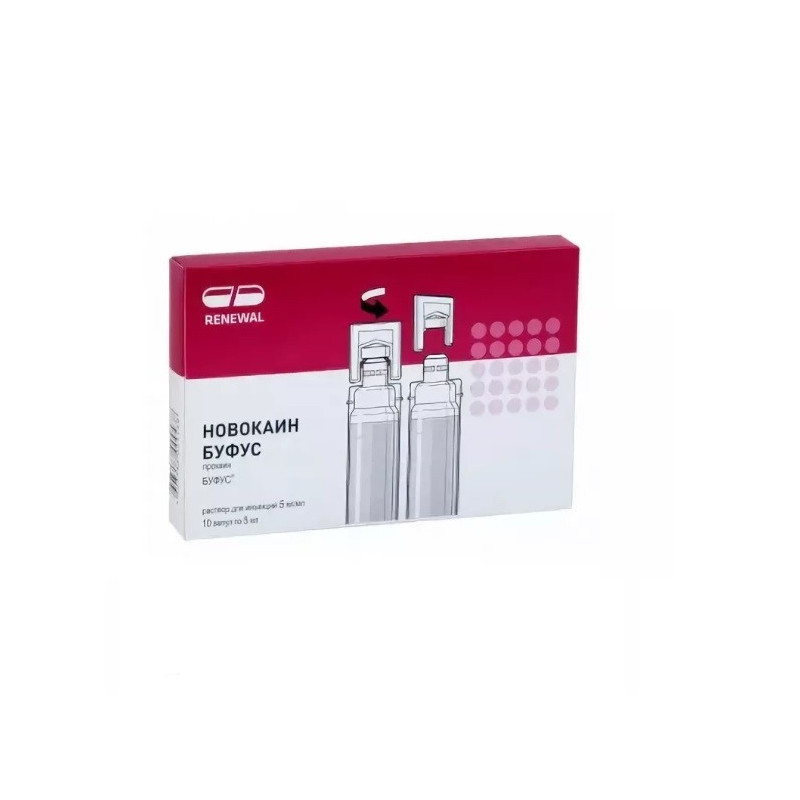



 All payments are encrypted via SSL
All payments are encrypted via SSL
 Full Refund if you haven't received your order
Full Refund if you haven't received your order
Injection
In 1 l solution for injection contains: procaine hydrochloride 5 g.
Excipients: hydrochloric acid 0.1 M p H 3.8-4.5, water for injection - 1 l.
In the ampoule 5 ml solution. In the package 10 ampoules.
Novocaine - local anesthetic. Violates the generation and conduction of nerve impulses mainly in non-myelin fibers. Being a weak base, it interacts with receptors of membrane sodium channels, blocks the flow of sodium ions, displaces Calcium from receptors located on the inner surface of the membrane. Changes the action potential in the membranes of nerve cells without a pronounced effect on the resting potential. Antiarrhythmic effect is associated with an increase in the effective refractory period, a decrease in excitability and automatism of the myocardium.
When absorbed or directly injected into the blood, it reduces the formation of acetylcholine and the excitability of cholinergic systems, has a ganglion-blocking effect, reduces spasm of smooth muscles, inhibits the excitability of the myocardium and motor areas of the cerebral cortex. It has analgesic and anti-shock activity, hypotensive and antiarrhythmic action.Eliminates the downward inhibitory effects of the reticular formation of the brain stem. Inhibits polysynaptic reflexes. In large doses, it can cause convulsions. It has a short anesthetic activity (the duration of infiltration anesthesia is 0.5-1 h). To reduce systemic effects, toxicity, and prolongation of the effect, it is used in combination with vasoconstrictors (adrenaline). With increasing concentration of solutions, it is recommended to reduce the total dose. It is effective (with intramuscular injection) in elderly patients in the early stages of diseases associated with functional disorders of the central nervous system (hypertension, spasms of the coronary vessels and brain vessels, etc.).
- Local anesthesia: infiltration, conduction, epidural, spinal.
- Vagosympathetic and perirephral blockade.
- Potentiation of the action of anesthetic agents with general anesthesia.
- Pain syndrome of various genesis (including with gastric ulcer and duodenal ulcer).
- Spasms of blood vessels, neurodermatitis, hemorrhoids, nausea.
Hypersensitivity.
Inside, in / to, in / m, in / in, by electrophoresis, rectally. For infiltration anesthesia. Possible appointment for intraosseous anesthesia. When vagosympathetic blockade - 30-100 ml of 0.25% solution. To eliminate the pain syndrome, they are applied orally, intramuscularly or intravenously: intravenously, from 1 to 10-15 ml of 0.25% solution is slowly injected into the vein; inside use a 0.25% solution to 30-50 ml 2-3 times a day. For circular and paravertebral blockade with eczema and neurodermatitis, a w / c injection of 0.25% solution is recommended.
Dizziness, weakness, arterial hypotension, allergic reactions (possible anaphylactic shock).
Not absorbed from the mucous membranes does not provide surface anesthesia. Together with a 0.1% solution, epinephrine hydrochloride is used at the rate of 1 drop per 2-5 ml of procaine solution.
Enhances the effect of anesthetic agents.
Symptoms: when used in excessive doses, excessive absorption is possible, accompanied by nausea, vomiting, a sudden cardiovascular collapse, increased nervous excitability, tremors and convulsions, and respiratory depression.
Treatment: general resuscitation. In the event of intoxication after injection into the muscles of the arms or legs, an urgent application of the harness is recommended to reduce the further flow of the drug into the general circulation.
In the dark place.
Novocaine